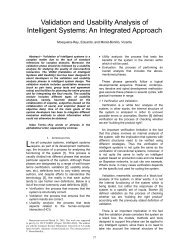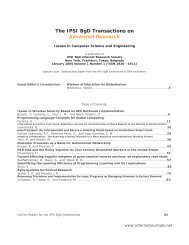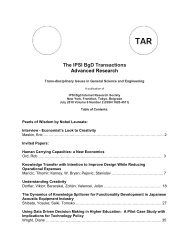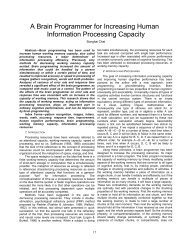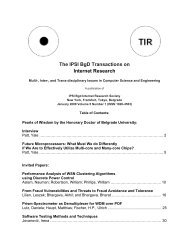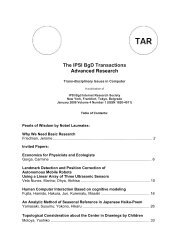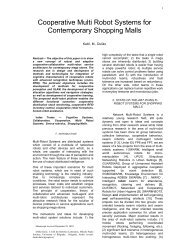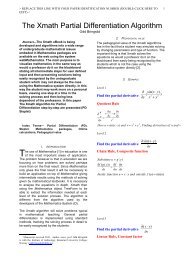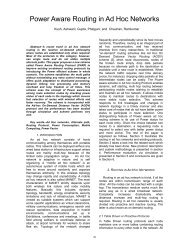The IPSI BgD Transactions on Internet Research - Welcome
The IPSI BgD Transactions on Internet Research - Welcome
The IPSI BgD Transactions on Internet Research - Welcome
You also want an ePaper? Increase the reach of your titles
YUMPU automatically turns print PDFs into web optimized ePapers that Google loves.
hypothesis language is lost.<br />
FORS [14] is the system that first used first<br />
order regressi<strong>on</strong>. It combined the expressive<br />
power of ILP with linear regressi<strong>on</strong>. It showed<br />
that first order regressi<strong>on</strong> is able to produce<br />
results. While 4S is based <strong>on</strong> principles laid by<br />
FORS, it is a new system. Several new<br />
techniques were developed and some old <strong>on</strong>es<br />
from FORS, that did not perform as expected,<br />
were eliminated. In 4S we also included<br />
extensive comparing of c<strong>on</strong>tinuous variables and<br />
the opti<strong>on</strong> to force the system to count <strong>on</strong>ly<br />
basically different examples to satisfy the minimal<br />
number of examples c<strong>on</strong>diti<strong>on</strong> (as described in<br />
Secti<strong>on</strong> 3.1).<br />
<str<strong>on</strong>g>The</str<strong>on</strong>g> system described in [29], [30] as well as a<br />
system described in [31] are also capable of<br />
handling numerical domains using background<br />
knowledge for comparis<strong>on</strong>s, and other numerical<br />
operati<strong>on</strong>s including regressi<strong>on</strong>. Since the main<br />
goal of the designers was to keep all capabilities<br />
of the original ILP engine, several compromises<br />
had to be d<strong>on</strong>e. In case of numerical domains,<br />
those systems cannot navigate efficiently through<br />
the search space before predicates predicting<br />
numerical values are added to the clause. To<br />
ease the navigati<strong>on</strong> through the search space<br />
and to produce meaningful clauses, the system<br />
requires the user to provide a refinement<br />
operator, cost calculati<strong>on</strong> and pruning. This<br />
certainly enhances the performance of the<br />
system compared to 4S, but it also significantly<br />
decreases the ease of use and practical<br />
applicability to real-live problems. On the<br />
theoretical-ability scale, those systems outrank<br />
4S, but judging from results presented in [29] and<br />
[30] <strong>on</strong>e gets the impressi<strong>on</strong> that 4S is at least<br />
competitive in terms of practical use, as it does<br />
not require c<strong>on</strong>stant involvement by the user.<br />
6. TEST DOMAINS<br />
6.1. Steel grinding domain<br />
<str<strong>on</strong>g>The</str<strong>on</strong>g> steel grinding domain data describes the<br />
relati<strong>on</strong>ship between the roughness of a steel<br />
workpiece and the sound produced by grinding<br />
that workpiece [13]. <str<strong>on</strong>g>The</str<strong>on</strong>g> idea is to enable<br />
automatic c<strong>on</strong>trol of the grinding process. An<br />
example is terminati<strong>on</strong> of the process when<br />
performance becomes unsatisfactory [12]. Since<br />
c<strong>on</strong>trol decisi<strong>on</strong>s can be quickly deduced from<br />
the roughness of the workpiece, our task was to<br />
predict roughness from the sound of grinding.<br />
<str<strong>on</strong>g>The</str<strong>on</strong>g> data was collected during an experiment<br />
where the workpiece was fitted with an<br />
accelerati<strong>on</strong> sensor. That data was then<br />
spectrally analyzed, and the following data was<br />
44<br />
available to 4S:<br />
• size of the area of whole spectrum<br />
• frequency of the maximum peak<br />
• frequency of the middle of the spectrum<br />
During the experiment the process of grinding<br />
was stopped and the surface roughness<br />
measured 123 times. Background knowledge<br />
predicates enabling 4S to compare variables<br />
were given (=).<br />
Table 2 Relative error of 4S <strong>on</strong> Steel grinding.<br />
min no. of<br />
examples<br />
all var.<br />
test<br />
two var.<br />
test<br />
<strong>on</strong>e var.<br />
test<br />
“no” var.<br />
test<br />
1 0.633 0.584 0.529 0.840<br />
2 0.656 0.594 0.518 0.629<br />
4 5.403 1.877 1.257 0.595<br />
6 0.550 0.470 0.536 0.624<br />
8 0.509 0.461 0.558 0.634<br />
10 0.508 0.452 0.545 0.657<br />
12 0.509 0.476 0.544 0.643<br />
14 0.508 0.473 0.547 0.656<br />
16 0.500 0.465 0.544 0.660<br />
18 0.500 0.453 0.558 0.662<br />
20 0.441 0.451 0.565 0.662<br />
30 0.443 0.455 0.559 0.655<br />
50 0.501 0.516 0.499 0.825<br />
80 0.457 0.464 0.674 0.965<br />
100 1 1 1 1<br />
Table 3 Relative error of FORS <strong>on</strong> Steel grinding.<br />
min no. of<br />
examples<br />
lin reg<br />
test<br />
no reg<br />
test<br />
lin reg, MDL<br />
test<br />
no reg, MDL,<br />
test<br />
1 0.74 0.79 0.73 0.62<br />
2 9.15 0.69 0.76 0.60<br />
4 1.01 0.55 0.71 0.58<br />
6 0.81 0.60 0.66 0.54<br />
8 0.78 0.58 0.63 0.59<br />
10 0.72 0.56 0.62 0.56<br />
12 0.69 0.63 0.63 0.64<br />
14 0.64 0.60 0.62 0.62<br />
16 0.70 0.57 0.70 0.57<br />
18 0.71 0.62 0.71 0.62<br />
20 0.74 0.64 0.74 0.64<br />
Experiments were c<strong>on</strong>ducted in the form of 10<br />
different sets c<strong>on</strong>sisting of 70% learning and 30%<br />
testing examples (same sets were used by<br />
FORS) and all combinati<strong>on</strong>s of minimal number<br />
of (original) examples in a clause (possible<br />
values 1, 2, 4, 6, 8, 10, 12, 14, 16, 18, 20, 30, 50,<br />
80, 100) and the type of linear equati<strong>on</strong> (allowed<br />
are all variables, 2, 1 and no variables - a<br />
predicti<strong>on</strong> of a c<strong>on</strong>stant). From the results <strong>on</strong> the<br />
learning and test data relative (compared to the<br />
predicti<strong>on</strong> of an average learning value) average<br />
error was calculated. <str<strong>on</strong>g>The</str<strong>on</strong>g> results are presented in<br />
Table 2.<br />
If we compare the results of experiments made<br />
with 4S in Table 2 and FORS [15] in Table 3 we<br />
can see that when regressi<strong>on</strong> is not permitted<br />
FORS (with or without MDL) performs better than<br />
4S. However with linear regressi<strong>on</strong> even when<br />
using MDL FORS overfits the data. <str<strong>on</strong>g>The</str<strong>on</strong>g> clause<br />
with the best results by 4S (made using linear



